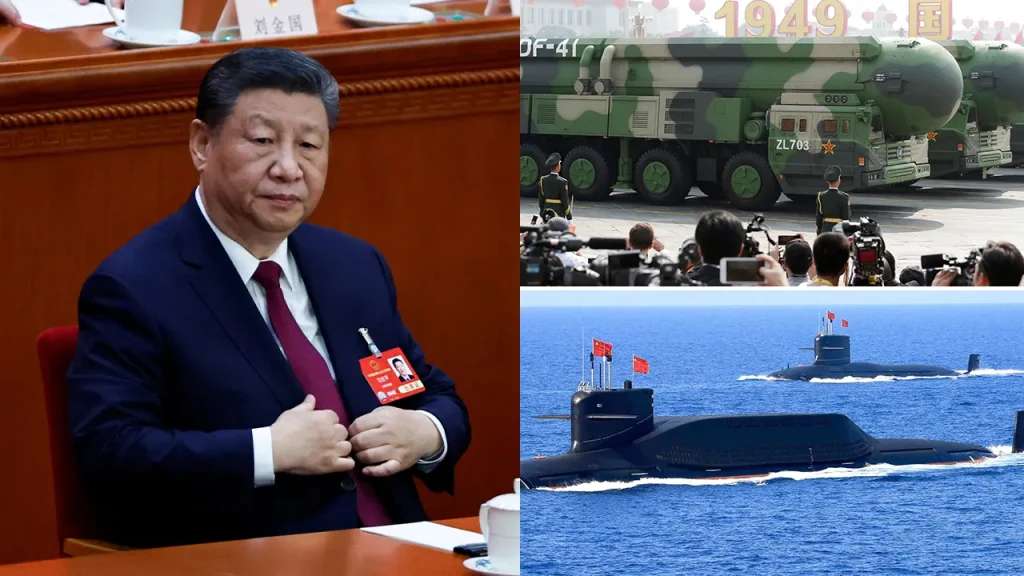A group of conservative lawmakers and military experts is raising alarms regarding the United States’ preparedness to face a potential conflict with China over Taiwan. A recently obtained video, set to be released by the Heritage Foundation, highlights concerns about the U.S. tactical nuclear arsenal being outdated and unable to effectively respond to new threats. The report points out that unless significant changes are made, the U.S. may struggle to deploy an adequate military response should China escalate its nuclear capabilities, particularly against Taiwan.
| Article Subheadings |
|---|
| 1) Concerns Over U.S. Nuclear Arsenal |
| 2) The Implications of an Outdated Strategy |
| 3) China’s Growing Nuclear Threat |
| 4) Political Perspectives and Calls for Action |
| 5) The Need for Modernization |
Concerns Over U.S. Nuclear Arsenal
A recent video by the Heritage Foundation has sparked intense debate among military experts and lawmakers regarding the U.S. nuclear arsenal’s readiness to confront the growing threats posed by China. The video outlines a scenario in which China could employ tactical nuclear weapons against U.S. military bases, particularly the Air Force Base in Guam, with devastating potential consequences. The loss of 3,000 lives in such an attack is underscored, reflecting the serious nature of these discussions. According to analysts, the U.S. arsenal predominantly consists of nuclear weapons that are considered outdated, some nearly 40 years old, raising questions about their effectiveness in a modern combat environment.
The Implications of an Outdated Strategy
The video emphasizes that the United States has significantly reduced its tactical nuclear capabilities since the Cold War. According to military experts, this reduction leaves the U.S. vulnerable if a conflict were to arise in the Indo-Pacific region. The strategy laid out by U.S. military officials has dramatically changed, shifting focus to counterterrorism in the Middle East at the expense of addressing threats in Asia. This perspective is alarming to some analysts who believe that the U.S. may be caught off-guard by a more aggressive China that is modernizing its own nuclear capabilities. The sentiment is echoed by Bob Peters, a strategic deterrence fellow at the Heritage Foundation, who claims the existing U.S. tactical nuclear weapons stocks are inadequate for contemporary challenges.
China’s Growing Nuclear Threat
Reports indicate that China is rapidly expanding its nuclear arsenal, with projections suggesting growth from approximately 500 warheads to over 1,000 by 2030. This dramatic increase raises significant concerns, especially as U.S. officials assess the future geopolitical landscape. The ongoing militarization by China includes not only an increased number of nuclear weapons but also the advancement of missile technology capable of delivering nuclear payloads. Analysts warn that China’s development of hypersonic missiles capable of bypassing existing missile defense systems presents a serious challenge for the U.S. military’s preparedness. Such advancements leave American military strategists grappling with how best to respond should hostilities arise, particularly concerning Taiwan.
Political Perspectives and Calls for Action
The video has also sparked political discourse among lawmakers. Sen. Deb Fischer (R-Neb.) voiced concerns about the United States’ past strategic decisions, indicating that previous assumptions—like controlling Russia following the Soviet Union’s breakup—may have misjudged China’s rising threat. Additionally, Rep. Chip Roy (R-Texas) criticized decades of focus on military engagements in the Middle East, suggesting they detracted from necessary deterrence strategies against the Indo-Pacific’s emerging threats.
The Need for Modernization
Current discussions emphasize the necessity for the United States to modernize its nuclear arsenal. Experts argue for a comprehensive update to the decades-old systems that have not been adequately maintained or replaced since the late 20th century. The prevailing sentiment is that the U.S. cannot rely on outdated weapons to deter modern threats from ambitious nuclear states. Moreover, political figures assert that the U.S. military must reassess its priorities and ensure that it is fully equipped to counter potential aggressors effectively. Recommendations include reopening the production of new tactical nuclear weapons to reestablish a credible deterrent against adversary states such as China.
| No. | Key Points |
|---|---|
| 1 | The U.S. nuclear arsenal is perceived as outdated, with many weapons nearly 40 years old. |
| 2 | China is predicted to significantly increase its nuclear warheads to over 1,000 by 2030. |
| 3 | Military experts warn that the U.S. may struggle to respond effectively to potential Chinese aggression in the Indo-Pacific. |
| 4 | Lawmakers urge the necessity of modernizing the U.S. nuclear capabilities to ensure national security. |
| 5 | Current strategies focusing on counterterrorism may have weakened U.S. preparedness against a rising China. |
Summary
The discussions initiated by the Heritage Foundation regarding the state of the U.S. nuclear arsenal and the implications of a possible conflict with China have sparked critical conversations across political and military circles. Highlighting the outdated nature of U.S. nuclear capabilities and China’s aggressive expansion of its military arsenal, analysts and lawmakers alike are urging immediate action to modernize America’s defense strategies. The urgency to adapt to a shifting geopolitical landscape underscores the challenges ahead as the U.S. navigates its role in an increasingly complex global arena.
Frequently Asked Questions
Question: Why is the U.S. nuclear arsenal considered outdated?
The U.S. nuclear arsenal is considered outdated due to the age of its weapons, many of which are over 35 years old and were meant to be replaced years ago, leading to concerns about their effectiveness in modern warfare.
Question: What is China’s plan for its nuclear arsenal by 2030?
China plans to grow its nuclear arsenal from 500 warheads to over 1,000 by 2030, reflecting its focus on enhancing its military capabilities and deterring U.S. involvement in regional conflicts.
Question: What actions are being proposed to modernize the U.S. military’s nuclear capabilities?
There are calls for the U.S. to update its nuclear arsenal, reestablish the production of new tactical nuclear weapons, and reassess military strategies to better prepare for potential threats from nations like China.
